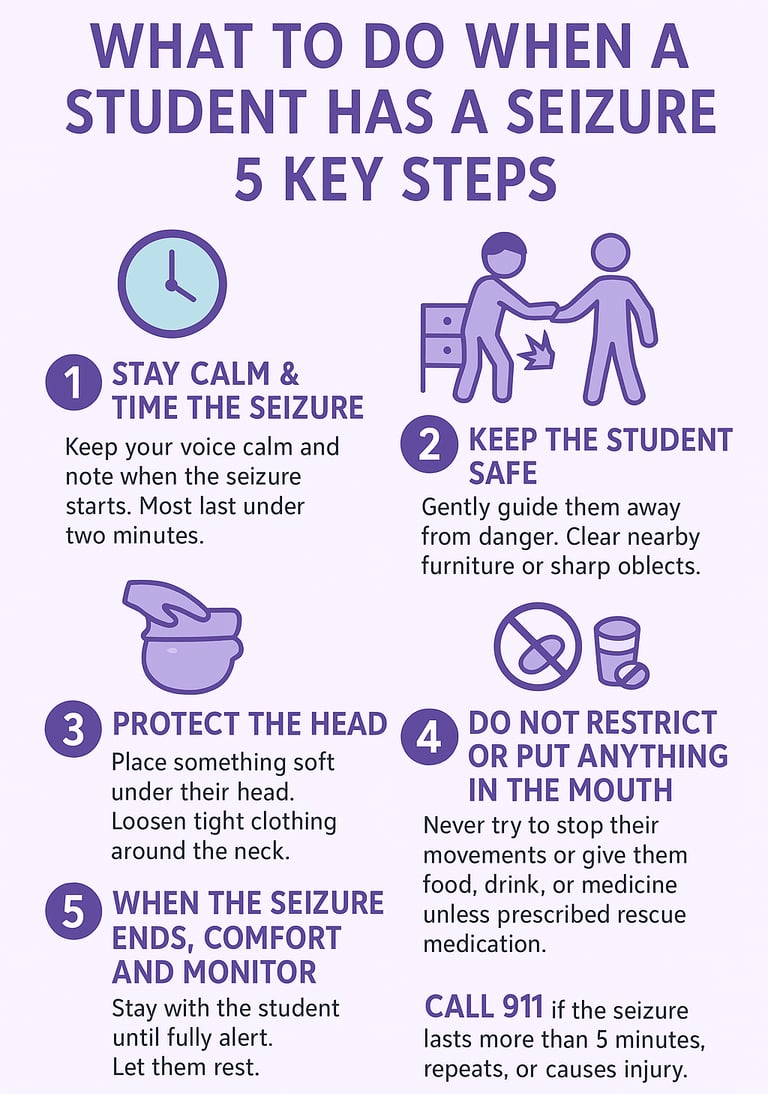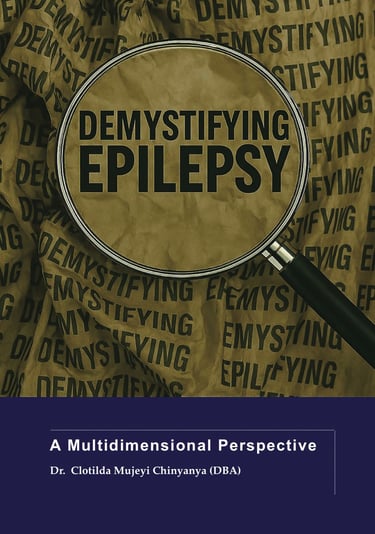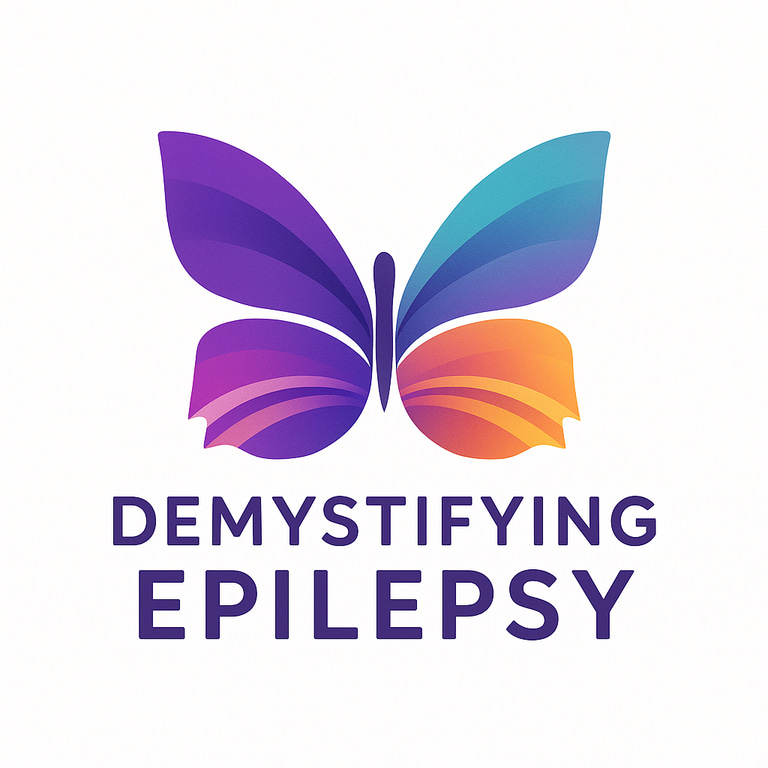Managing Epilepsy at School: A Guide for Teachers and Parents
Learn how to support students with epilepsy at school. Practical steps for teachers, parents, and staff, from seizure response to emotional care. Focus Keywords: epilepsy at school seizure first aid for teachers seizure action plan supporting students with epilepsy
Dr. Clotilda Chinyanya
10/24/20254 min read


School should be a place where every child feels safe, supported, and ready to learn. For students living with epilepsy, that goal is absolutely within reach with understanding, preparation, and collaboration.
1. Introduction
Context: Many teachers and parents may never have encountered a student with epilepsy, which can lead to uncertainty or anxiety.
Purpose: This guide helps bridge that gap equipping teachers and parents with practical knowledge and tools to support students with epilepsy in the school setting.
2. Understanding Epilepsy in the School Setting
What is epilepsy?
A brief, accessible definition: a neurological condition characterized by recurrent, unprovoked seizures.
(See WHO for global facts about epilepsy, including prevalence and common misconceptions.) (World Health Organization)Types of seizures teachers may observe
Absence seizures may look like brief staring spells or daydreaming, often lasting a few seconds. A child can experience several absence seizures per day (brief lapses of awareness)
Focal / partial seizures can cause confusion, repetitive movements, or unusual sensations (may affect one part of body or awareness)
Generalized tonic-clonic seizures involve loss of consciousness and full body shaking (convulsions, full-body shaking)
Each child is unique
Seizure types, frequency, triggers, and recovery differ from student to student. Recognizing these differences is the first step toward providing effective support.
(For more background information, see the World Health Organization’s overview of epilepsy).
3. The Role of Teachers
Teachers are often the first to witness a seizure in the classroom, so their response is critical. Knowing what to do — and staying calm — helps ensure the student’s safety and comfort.
Recognizing and Responding
· Spotting seizure signs — Even subtle ones (e.g. brief staring, repetitive motions)
· First aid during a seizure
oStay calm and note the time when the seizure begins.
oKeep the student safe. Gently guide them away from danger and clear the area of hard or sharp objects.
oProtect the head. Place something soft under it and loosen tight clothing around the neck.
oDo not restrain the student or put anything in their mouth.
oStay with them until they are fully alert again, offering reassurance and privacy.
Call for medical help if:
1. Seizure lasts longer than 5 minutes
2. Another seizure follows immediately
3. The student is injured, has trouble breathing, or doesn’t wake easily
After a seizure, students may feel tired, disoriented, or embarrassed.
· Post-seizure support in class
o Give rest time or allow the student to go to the nurse
o Offer flexibility with deadlines or make-up work
o Watch for attention or memory difficulties
· Promoting inclusion
o Avoid drawing unnecessary attention to the incident
o Encourage empathy among classmates
o Avoid letting stigma or fear isolate the student
4. The Role of Parents
Parents play a vital role in preparing schools to handle seizures and support their child’s overall wellbeing.
Parents should:
Provide a Seizure Action Plan (SAP)
Share a completed, up-to-date SAP with the school (teachers, nurse, administrators).Keep the school informed
Report changes in medications, seizure patterns, side effects.Empower your child
Encourage age-appropriate self-advocacy (e.g. explaining their condition to trusted adults, or telling teachers when they feel unwell or sense a coming seizure).Regular check-ins
Schedule meetings with teachers and staff to assess how things are going academically and socially.
When parents and educators share information and trust, students feel safer and more confident at school.
5. Creating a Seizure Action Plan
A good Seizure Action Plan (SAP) ensures that everyone knows what to do in an emergency. It typically includes:
Seizure types, usual duration, and recovery time
First aid steps (what to do immediately during a seizure)
Emergency / rescue medication instructions (if prescribed)
When to call 911 or seek help
Contact information (parents, neurologist, emergency contacts)
Student-specific considerations (known triggers, medical history, allergies)
Downloadable templates & resources
Epilepsy Foundation’s fillable Seizure Action Plan (General / School Use) (Epilepsy Foundation)
Child Neurology Foundation SAP (fillable) (Child Neurology Foundation)
Acute Seizure Action Plan (shorter version) (Epilepsy Foundation)
SAP examples and templates (various versions) (Seizure Action Plans)
Schools should keep accessible copies for relevant staff (teachers, nurses, administrators).
6. Supporting Academic & Emotional Wellbeing
Epilepsy can affect more than just physical health. Children with epilepsy may face challenges beyond seizures: For example:
Fatigue — from seizures or medications
Cognitive impacts — attention, memory, processing speed
Emotional stress — anxiety about future seizures, feeling “different”
Here are some ways schools can help:
Allow rest breaks after a seizure
Give extra time for tests and assignments
Provide quiet spaces if overwhelmed
Maintain open dialogue — encourage students to share feelings
Partner with school counselors or psychologists
Implement peer education (age-appropriate) to reduce stigma
A child who feels understood and accepted is far more likely to succeed academically and socially.
7. Building a Supportive School Environment
Creating an epilepsy-aware environment goes beyond first aid — it’s about fostering inclusion and respect. Schools can take proactive steps by:
Training & awareness
Offer epilepsy / seizure first aid training to teachers and staffStudent education
Present a simple, respectful class lesson about epilepsy (myths vs realities)Promote empathy
Encourage inclusive practices (buddy systems, peer support)Regular review & drills
Practice “seizure drills” so staff know how to respond confidently (Epilepsy Foundation)
8. When to Seek Additional Support
If seizures change in frequency, severity, or pattern
When academic or emotional difficulties escalate
Collaborate with neurologists, epilepsy specialists, or medical teams
Engage local epilepsy support organizations
For additional resources, visit:
9. Conclusion & Call to Action
Children with epilepsy can succeed academically, socially, and emotionally, especially when schools and families work together in empathy and readiness. By understanding what epilepsy is, knowing how to respond to seizures, and working together with empathy, teachers and parents can create an environment where every child feels safe, capable, and included.
If this guide has been helpful:
Share it with your school community (teachers, staff, parents)
Download a Seizure Action Plan template and share it with your child’s school
Subscribe to Demystifying Epilepsy for more resources, stories, and guides
Let us know — comment your experience or questions below (or email us)
Together, we replace fear with knowledge, stigma with acceptance, and uncertainty with confidence, one classroom at a time. 💜
Free Resources
Infographic: “What to Do When a Student Has a Seizure – 5 Key Steps”


